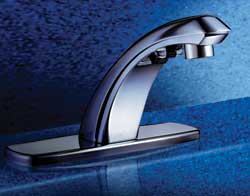Factors For Achieving Water Conservation Excellence:
The North Carolina Department of Environment and Natural Resources' Division of Pollution Prevention and Environmental Assistance offers this information about domestic water use: consumption by lavatories, water closets, urinals and showers accounts for the largest amount of consumption for office buildings, schools/universities, hotels/motels and healthcare facilities. Each of these types of buildings consumes more than 40 percent of their total water balance in the restroom. Controlling this consumption should be a high priority of today's architect. As costs for potable water continue to escalate over the next few years-influencing the bottom-line in ways it never has in the past-implementing water-efficient designs that reduce that need will save money and resources in the years to come, and result in a more sustainable structure.
|
Schools
For example, more than 50 million children and six million adults enter public schools each day during the school year. The actual water needed to meet that daily demand is staggering; what makes it more compelling is that the average school building is over 40 years old. In 2003, over $48 billion was spent on construction in this marketplace, and as schools today face a shortage of funding and a lack of awareness of what sustainable designs can do for facilities, the role of the architect is further enhanced by having a unique education-oriented environment within which to practice conservation. Movements toward sustainable schools are well developed in some areas, but many areas still practice old techniques, thus missing the opportunity to impact a large consumer of the domestic water supply.
Hospital and Healthcare Facilities
Consider the unique requirements of many of our hospitals and healthcare facilities. These buildings are similar to "mission critical" buildings in that they operate 365 days a year, and incorporate equipment that consumes vast quantities of energy and water. In thinking about sustainable design, architects should consider the ASHE (the American Society of Healthcare Engineers) guidance statement from 2002 that focused on the holistic nature of sustainable design: "Local air and water quality is also significantly affected by building design choices. Off-gassing building materials and finishes, construction equipment and HVAC systems directly emit VOCs, particulates and other materials that can result in the formation of ground level ozone (smog), and cause allergic attacks, respiratory problems and other illnesses. Land use and transportation planning, landscape and water management on the grounds and water conservation efforts within the building will influence the amount of toxic emissions released to the water and air throughout the life of the building."
Consequently, it isn't just a "water" decision, but a building decision the architect faces when confronting sustainable design with water conservation as a goal. Water-efficient design strategies actually balance water quality and quantity demands within a building. Architects must, therefore, take a "systematic look to identify potential water sources, how water is used in the building and how it flows around the building site to reduce water usage and wastewater discharges"-good advice in today's water-conscious environment.










